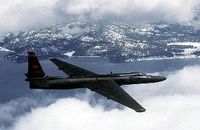U-2S/TU-2S - Mission: The U-2 provides high-altitude, all-weather surveillance and reconnaissance, day or night, in direct support of U.S. and allied forces. It delivers critical imagery and signals intelligence to decision makers throughout all phases of conflict, including peacetime indications and warnings, low-intensity conflict, and large-scale hostilities.
Features: The U-2S is a single-seat, single-engine, high-altitude reconnaissance and surveillance aircraft. Long and narrow wings give the U-2 glider-like characteristics and allow it to quickly lift heavy sensor payloads to unmatched altitudes, keeping them there for extended periods of time. The U-2 is capable of gathering a variety of imagery products, including multi-spectral electro-optic, infrared, and synthetic aperture radar in addition to the high-resolution, broad-area synoptic coverage provided by a traditional “wet film” optical bar camera.
The U-2 also has the capability to carry a signals intelligence payload. All intelligence products except for wet film can be transmitted in near real-time anywhere in the world via air-to-ground or air-to-satellite data links, rapidly providing critical information to combatant commanders.
Routinely flown at altitudes over 70,000 feet, the U-2 pilot must wear a full pressure suit similar to those worn by astronauts. The low-altitude handling characteristics of the aircraft and bicycle-type landing gear require precise control inputs during landing; forward visibility is also limited due to the extended aircraft nose and “taildragger” configuration. A second U-2 pilot normally “chases” each landing in a high-performance vehicle, assisting the pilot by providing radio inputs for altitude and runway alignment. These characteristics combine to earn the U-2 a widely accepted title as the most difficult aircraft in the world to fly.
 | An Air Force U-2 Dragon Lady flies a training mission. (U.S. Air Force photo by Master Sgt. Rose Reynolds) The U-2 is a single-seat, single-engine, high-altitude, reconnaissance aircraft. |
Photo, Text Disclaimer:
1. Air Force Link is provided as a public service by the Office of the Secretary of Air Force (Public Affairs).
2. Information presented on Air Force Link is considered public information and may be distributed or copied. Use of appropriate byline/photo/image credits is requested.
Generally speaking, works created by U.S. Government employees are not eligible for copyright protection in the United States. See Circular 1 "COPYRIGHT BASICS" from the U.S. Copyright Office.
The U-2 now has a General Electric F118-101 engine, fuel efficient and lightweight, which negates the need for air refueling on long duration missions. The U-2S Block 10 electrical system upgrade replaced legacy wiring with advanced fiber-optic technology and lowered the overall electronic noise signature to provide a quieter platform for the newest generation of sensors. The Block 20 upgrade provides a complete redesign of the cockpit with digital color multifunction displays and up-front avionics controls to replace the 1960s-vintage round dial gauges.
Future modifications include an advanced electronic warfare system; an improved dual data link, electro-optical pilot viewsight, and improved signals intelligence payload.
Related: Public Domain Clip Art Archive June - July 2005 and Aircraft
Nanotechnology Today or Public Domain Clip Art and Republican National Convention Blog














No comments:
Post a Comment